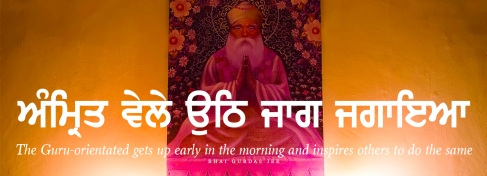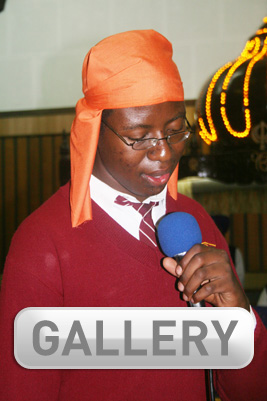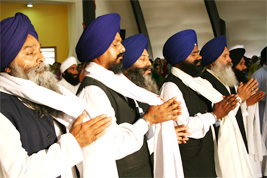
When Sarabjit Singh Dhunda, who is growing in popularity (and selective controversy), flew into Kenya for the first time on invitation of a local Nairobi Gurudwara in November 2013, not many knew about his powerful discourses or just what baggage he came with. His tour was not widely advertised but when I received a poster on WhatsApp announcing his visit, I immediately initiated a debate on social media to get input from the global sangat on what we need to be aware of in case we get to witness issues that may mislead or disillusion the still very naive and uninformed sangat of Kenya. The post attracted a flurry of comments – most of them against him, warning the sangat to be wary of his unfortunate utterances as he has been reprimanded earlier by the Akaal Takht, and even courted discontent amongst sangat of other countries, especially that of the UK. While I appealed for a neutral approach by way of at least being in the know of what he is known be controversial on, and at least focus on what we do agree on, much of these calls for reason did not go down well with those taking sides for or against him. The situation soon turned into something never witnessed in Kenya before, where a visiting preacher ended up being made to feel unwelcome and informed that he could be ‘sent packing home’ in case he spoke against certain issues that would lead the sangat ‘astray’.
All said and done, I opened a forum on the facebook post that would invite people to pose their questions and apprehensions against Dhunda who I planned to privately interview so I could at least be the voice of reason between the two differing sides. Questions came in, and I noted them down as I prepared to come face-to-face with such a powerful name in the Sikh community around the world today.
When I met him following 4 days into his visit, and after having attended his sittings, I made my intentions clear to him on the purpose of the interview – which was to understand his perspectives and also to table concerns that some sangat have against him. I had him know that I would be video-recording the interview which he agreed to.
We spent over 90 minutes of cross-discussions on the questions I had brought along – most of them touching on general Sikhi, but as soon as we got into come touchy topics, he answered all my questions, but became edgy and within a minute or two, declared the interview done with. He probably began to sense the questions pertaining to the controversial issues may lead to further discontent and misunderstanding in the sangat – which he had faced enough of already so far in his preaching years. Despite having assured him that the intention was merely to bridge the divides through honest vichaar, he pulled away into mere one word responses by which time I lost the interest of the whole exercise altogether, for we were getting nowhere. My own learning aside from the questions asked, my bigger idea was to get both sides of the divide to tackle the issues more maturely and in humility. But that was not forthcoming from either side. And as I wrapped and packed up, he insisted that we make public only the generic questions and filter out the ones that he was not comfortable with being posted. He wanted to ‘approve’ the final cut before we could put it up on YouTube. For reasons I understand, or best known to him, he chose to censor his own views. This left me disheartened that the purpose of the interview failed to materialise with all the trust and humility I had assured Dhunda of.
Having left the interview, I came back to the office ever so convinced how Sikhs have become their own worst enemies, and against their own good. The ones against the view of the likes of Dhunda (who I personally respect for his vast knowledge in Sikhi) have no idea of how to conduct themselves through civil and humble vichaar in Gurmat, Gurbani and Rehat and choose to retort through harsh words, anger and ego. It is easier to reject someone just on the basis of disagreeing with a few issues than to counter-defend them through knowledge and wisdom of Sikhi. I found Dhunda equally hard to reason with because the one thing I look for in a Sikh is humility and I found it lacking in him. Both sides are filled with ego, no one even gives a thought to the humble ways of Nanak, but ready to draw daggers at a mere difference of opinion. This is what we have come down to – we have gathered knowledge but wisdom has lingered. We have studied books and Gurbani, but not understood their depths and failed to apply to our own selves before going out in public to speak on behalf of sangat.
Following the ordeal of the Dhunda interview, I decided to scrap the whole idea of even publishing the interview – for I did not want to post what pleases either side, but rather what benefits we can draw as a Panth. We claim to be be brave – but one side refuses to face the other (on the pretext of being busy with better things) and the other chooses to censor his own self (on the pretext of not wanting to stir matters even further). Neither side is brave enough for the panth, but hiding behind their own egos. That is the observation – not judgement – of what I have made of trying to reason between the two sides of a community that has yet to learn how to sit together in humility and accept the good in each other and help reason out the differences.
This one issue is a true reflection of our state as a Panth. We at war with each other – we all consider ourselves lions but none wants to battle out through reason and humility to reduce the discontent within the Sikhs themselves so that we may shine as Guru Nanak originally intended us to. We are the biggest losers here and if this is our take on Panthic issues, we might as well ask the outside enemy to down their weapons against us for we are perfectly capable of bringing our own selves down better without their help because we doubt each other and trust not even the self, let alone another.
Our differences aside, I have otherwise witnessed for myself how his 10-day tour immensely benefited the general sangat. He spoke on various issues that Sikhs are entangled in due to ignorance, arrogance and apathy and much of the sangat has probably become more aware of Sikhi than they had ever been before. And for that, I must offer my gratitude to Bhai Sarabjit Singh Dhunda on enlightening Kenya’s sangat on matters of Sikhi that we all need to be aware of to help make our lives worthy and usefulness of the human birth. His recorded discourses in Nairobi will be made available on YouTube in days to come.













